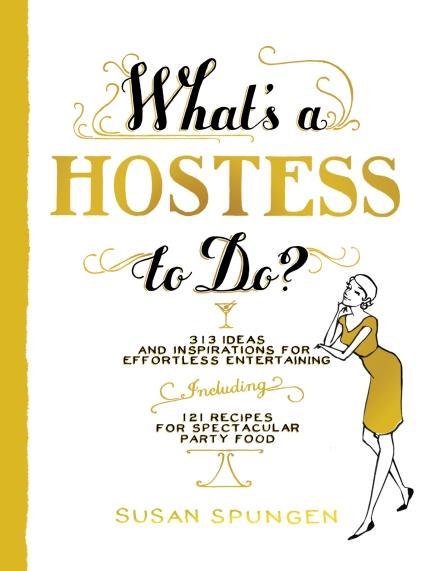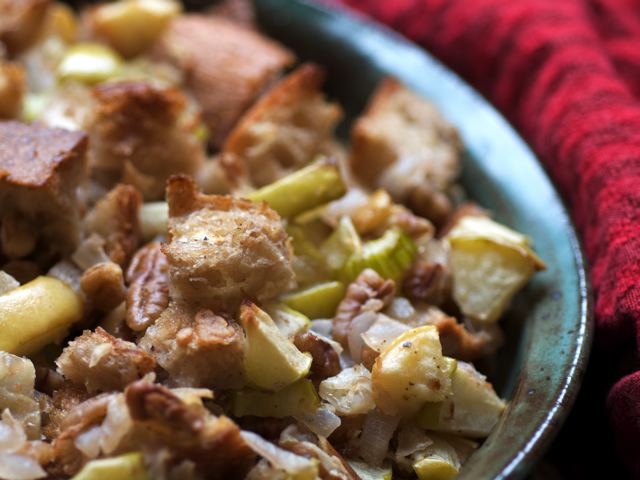
reference-image, l
(article, Susan Spungen)
[%pageBreakSettings nobreak=true][%adInjectionSettings noinject=true] h3. From the chapter titled "Holidays and Other Special Days" h4. How to Prepare Stuffing Stuffing is endlessly variable. The same basic technique is used to make stuffing (or dressing, as it is known if it’s cooked outside the bird), no matter what flavor combination you choose. [[block(sidebar). h1. About the book and author Susan Spungen is a cook, recipe developer, food stylist, editor, and author. She emphasizes "cooking as an art form, a communal pleasure, and an immensely satisfying personal achievement." In What's a Hostess to Do?, her second book, Spungen tackles the challenge of hosting a party with minimal effort and maximum entertainment. Reprinted with permission from Artisan. Copyright © 2013. ]] Start with the aromatics. Use some kind of onion (1 or 2 large ones for an average batch of stuffing), celery, and/or fennel, and whatever other aromatic ingredients you choose. Sauté with as much butter and/or olive oil as you want to use. You can use as little as a tablespoon or two if you want to keep it lean, and as much as a stick of butter if you like it rich. Then add any vegetables you’d like to use, and sauté briefly. Season lightly as you go. Add some cooking liquid, and bring to a boil to combine the flavors. (You can add more liquid later if the stuffing isn’t moist enough, so use about 2 cups to start.) Pour over the bread, which should be cubed and dried out or toasted, in a big bowl. Add whatever fruits, cooked meat, and nuts you’d like to use, and toss well. Taste for seasoning, and adjust with salt and plenty of black pepper. You can add some more herbs at this point, if you like, and an egg or two, but you don’t need to. Squeeze some of the stuffing in your hand. If it doesn’t quite hold together, add more liquid until it does. Refrigerate until needed. Use this list for inspiration and then experiment with your own creation. Aromatics (choose 1 to 3) Carrots, celery, onions, garlic, fennel, thyme, rosemary, sage, parsley, marjoram, oregano, orange zest Vegetables (choose 1 to 3) Turnips, celeriac, bell peppers, kale, squash, mushrooms, corn Cooking Liquid (choose 1) Vegetable stock, chicken or turkey stock, veal stock, orange juice, water, sherry Bread (choose 1) Corn bread; white, wheat, or sourdough bread; ciabatta; focaccia; baguette; rye Fruit (choose 1 or 2) Fresh or dried cranberries, raisins, dried apricots, apples, pears, grapes, dried currants Cooked Meat (choose 1) Pork or turkey sausage (removed from the casing), bacon or pancetta, ground beef Nuts (choose 1) Hazelnuts, walnuts, pecans, pine nuts, chestnuts [%image feature-image float=right width=400 caption="Stuffing is a great plan-ahead dish."] If you want to stuff the bird, stuff it loosely just before roasting, and bake any remaining dressing on the side in a shallow baking dish. Or bake it all on the side, dotted with butter if you like a crunchier top. Bake at 350 or 375 degrees for 30 to 40 minutes, until piping hot and golden brown on top. h4. Tips for Making Stuffing Even Better There are a few rules of thumb that will improve any stuffing. If you’re using meat, such as sausage or giblets, be sure to cook it before combining it with the other ingredients, whether you plan to stuff the bird or cook the stuffing or “dressing” in its own pan. This way you can be sure you avoid any contamination from undercooked meat. For the same reason, don’t stuff your bird until just before cooking it. You can make the stuffing well in advance, but keep it stored separately in the fridge. Make your own bread crumbs, and use day-old bread — or several days old if you like your stuffing on the dry side. (The amount of broth you add and whether you toast the bread also depend on your preferences for a softer, wetter stuffing or a looser version with more texture.) To make your own breadcrumbs, you can also cut a fresh loaf of bread and leave it out to dry overnight or in a warm oven. Regardless of the type of bread or the degree of dryness, the “crumbs” should really be chunks. Don’t grind the bread down to a crumble, or you’ll end up with a dense, pasty stuffing. If you use a store-bought product, choose croutons rather than breadcrumbs, and increase the amount of liquid you add because they’ll be very dry. Culinate editor's note:* Check out these featured stuffings, too: Apple and Sausage Stuffing, Whole-Wheat Thanksgiving Couscous, Wild Rice Dressing with Mushrooms, Cranberries, and Hazelnuts, and Apple-Pecan Stuffing.

reference-image, l

feature-image, l

featurette-image, l

promo-image, l

newsletter-image, l